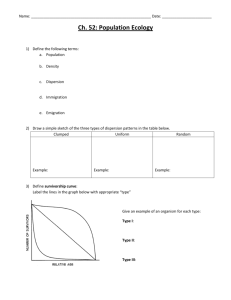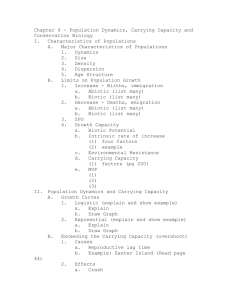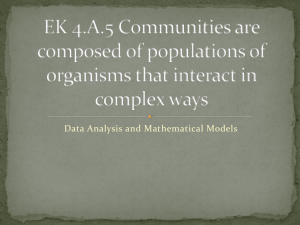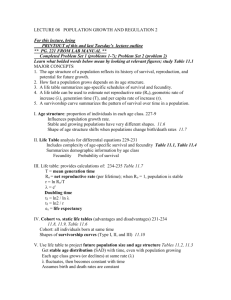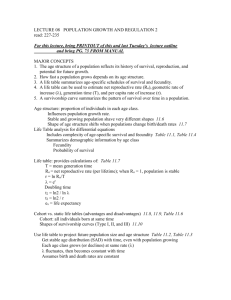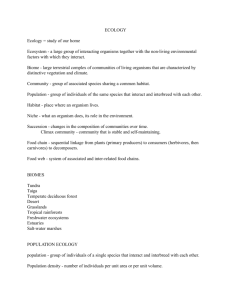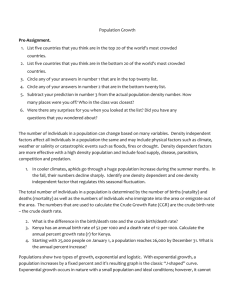Ch 8 - MHSAPEnvironmental
advertisement
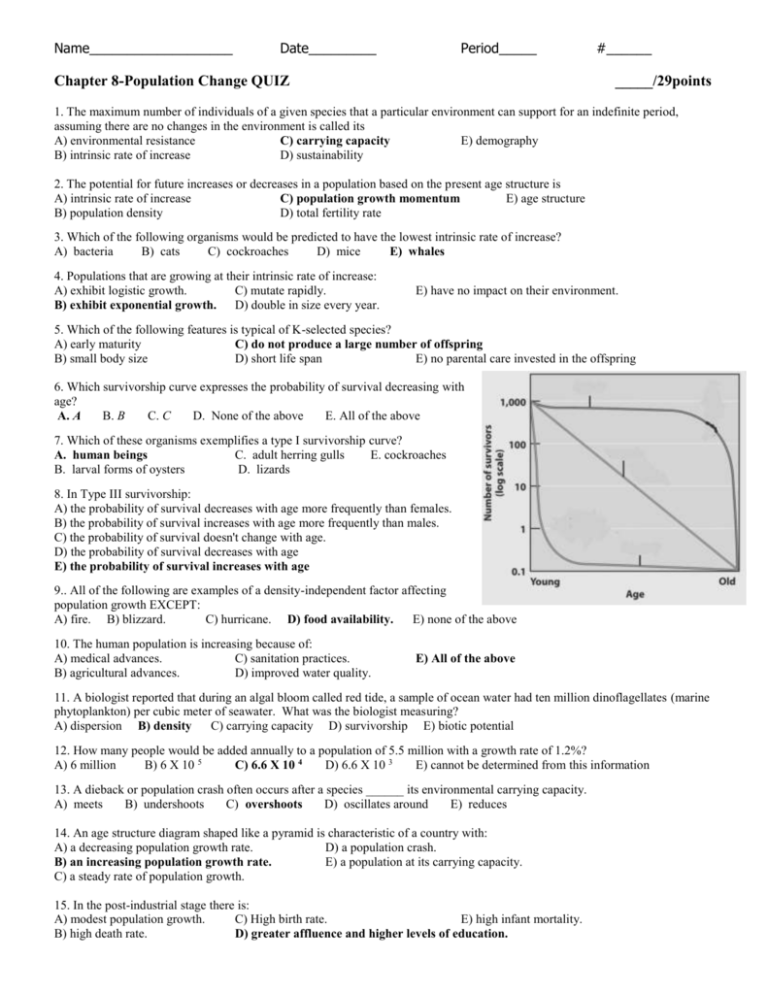
Name___________________ Date_________ Period_____ Chapter 8-Population Change QUIZ #______ _____/29points 1. The maximum number of individuals of a given species that a particular environment can support for an indefinite period, assuming there are no changes in the environment is called its A) environmental resistance C) carrying capacity E) demography B) intrinsic rate of increase D) sustainability 2. The potential for future increases or decreases in a population based on the present age structure is A) intrinsic rate of increase C) population growth momentum E) age structure B) population density D) total fertility rate 3. Which of the following organisms would be predicted to have the lowest intrinsic rate of increase? A) bacteria B) cats C) cockroaches D) mice E) whales 4. Populations that are growing at their intrinsic rate of increase: A) exhibit logistic growth. C) mutate rapidly. B) exhibit exponential growth. D) double in size every year. E) have no impact on their environment. 5. Which of the following features is typical of K-selected species? A) early maturity C) do not produce a large number of offspring B) small body size D) short life span E) no parental care invested in the offspring 6. Which survivorship curve expresses the probability of survival decreasing with age? A. A B. B C. C D. None of the above E. All of the above 7. Which of these organisms exemplifies a type I survivorship curve? A. human beings C. adult herring gulls E. cockroaches B. larval forms of oysters D. lizards 8. In Type III survivorship: A) the probability of survival decreases with age more frequently than females. B) the probability of survival increases with age more frequently than males. C) the probability of survival doesn't change with age. D) the probability of survival decreases with age E) the probability of survival increases with age 9.. All of the following are examples of a density-independent factor affecting population growth EXCEPT: A) fire. B) blizzard. C) hurricane. D) food availability. E) none of the above 10. The human population is increasing because of: A) medical advances. C) sanitation practices. B) agricultural advances. D) improved water quality. E) All of the above 11. A biologist reported that during an algal bloom called red tide, a sample of ocean water had ten million dinoflagellates (marine phytoplankton) per cubic meter of seawater. What was the biologist measuring? A) dispersion B) density C) carrying capacity D) survivorship E) biotic potential 12. How many people would be added annually to a population of 5.5 million with a growth rate of 1.2%? A) 6 million B) 6 X 10 5 C) 6.6 X 10 4 D) 6.6 X 10 3 E) cannot be determined from this information 13. A dieback or population crash often occurs after a species ______ its environmental carrying capacity. A) meets B) undershoots C) overshoots D) oscillates around E) reduces 14. An age structure diagram shaped like a pyramid is characteristic of a country with: A) a decreasing population growth rate. D) a population crash. B) an increasing population growth rate. E) a population at its carrying capacity. C) a steady rate of population growth. 15. In the post-industrial stage there is: A) modest population growth. C) High birth rate. E) high infant mortality. B) high death rate. D) greater affluence and higher levels of education. 16. Which of the following populations would have a growth rate of zero? A) b= 100, d=50. i=0, e=100 C) b= 100, d=50. i=75, e=100 B) b= 100, d=50. i=50, e=100 D) b= 100, d=50. i=100, e=100 E) b= 100, d=50. i=150, e=10 17. What is the doubling time for a population if the annual growth rate is 5%? A) 5 years B) 10 years C) 14 years D) 1.4 years E) cannot be determined from this information 18. All of the following are characteristics of an r-selected population EXCEPT: A) It has a high intrinsic rate of growth. B) The onset of reproduction is at an early age. C) There is extensive parental care of offspring D) It is likely to occur in variable environments E) There are many offspring per reproductive event. 19. At which point on the graph is the population size increasing most rapidly? A) Point A B) Point B C) Point C D) Point D E) Cannot be determined from this graph 20. Using the graph, identify the letter that corresponds to the carrying capacity for this population. A) Point A B) Point B C) Point C D) Point D E) Cannot be determined from this graph 21. Given a population growth rate of +0.18%, you would expect the population to: A) increase rapidly. C) remain unchanged. E) continue to decrease, but very slowly. B) continue to increase, but very slowly. D) decrease rapidly. 22. Given a population growth rate of –3.0%, you would expect the population to: A) increase rapidly. C) remain unchanged. E) continue to decrease, but very slowly. B) continue to increase, but very slowly. D) decrease rapidly. 23. If b=.05 and d=.02, then r, growth rate of a population, increased by what percentage? A. 1% B. 10% C. 3% D. 30% E. .03% 24. In a human population undergoing the demographic transition, which of the following generally decreases first? A. birth rate B. Death rate C. Avg. family size D. Life expectancy E. level of education 25. Emigration a. is one-way movement of individuals into the area of an established population. b. is one-way movement of individuals into an uninhabited area. c. is one-way movement of individuals out of a particular population to another area. d. is the repeated departure and return of individuals to and from a population area. 26. Limits set by a surrounding or an environment on reproduction are called A) biotic potential. B) environmental resistance. C) natural increase. D) demographics. 27. Factors that limit growth and produce population equilibrium are known as A) predation conflicts C) biotic potential B) diebacks D) environmental resistance E) doubling time. E) fertility factors 28. In calculating growth rate, dispersal refers to: A. immigration B. emigration C. natural increase D. both a and b 29. In the real world, many factors determine the numbers of organisms in any one population. Yet a SUPERFLY population with unlimited food and no mortality would show what types of growth? A) exponential B) logistic C) linear D) Mathusian E) unpredictable 30. Which of the following equations accurately represents population growth? A) = (d – b) + (i – e) D) = (b + d) ÷ (e + i) E) None of the above B) = (b + d) - (i + e) C) = (b – d) ÷ (i – e)

